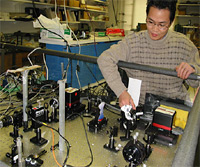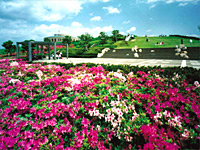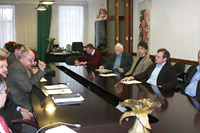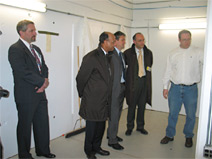 |
|
|
 |
University of Michigan Experiments with Silicon Microstrip Detectors

Haijun Yang of the University of Michigan adjusts the alignment of the frequency scanned interferometer system. |
Because high precision measurements will be the hallmark of experiments at the International Linear Collider, the project will require a detector with highly technical components to accurately measure the properties of the emerging particles. From beam position monitors to measuring particle flow, groups of physicists at universities across the U.S. are contributing to detector designs for the ILC. A group of researchers at the University of Michigan is contributing to international studies on the charged particle tracker, a critical component that measures the trajectories of electrically charged particles as they cross a magnetic field.
By measuring how much the field bends the particles, physicists can determine their energies. For particles traveling close to the speed of light, however, this bending is minimal and difficult to measure. Silicon microstrip detectors are a leading candidate for finding these small deflections. Consisting of multiple layers of thin silicon planes, these microstrips measure the passage of charged particles to a statistical precision better than 10 millionths of a meter, or 10 microns. The position and stability of the silicon layers play a large role in achieving accurate measurements, making it very important to minimize any disturbances to the ultra light strips.
Read more...
-- Keith Riles, University of Michigan
|
 |
|
|
 |
Upcoming meetings, conferences, workshops
International Symposium on Detector Development in Particle and Astroparticle Physics and Synchrotron Radiation
SLAC
3-6 April 2006
ILC Americas Regional Team Review
ILC - Americas
FNAL
4-6 April 2006
ILC Software and Physics Meeting
Cambridge
4-6 April 2006
MAC Review
Fermilab
6-7 April 2006
Polarized Positrons Workshop
POSIPOL 2006
CERN
26-28 April 2006
Linear Collider Forum of America Industrialization Meeting
SLAC
1-2 May 2006
HEP Forum
Cosener's House, UK
6-7 May 2006
European GDE meeting
DESY
10 May 2006 (16:00)
ILC positron source meeting
Budker Institute of Nuclear Physics
BINP, Novosibirk, Russia
10-12 May 2006
Electron Accelerator R&D for the Energy Frontier
LAL Orsay, France
15-17 May 2006
International Accelerator School for Linear Colliders
Sokendai, Graduate School for Advanced Studies
Hayama, Japan
19-27 May 2006
InterAction Meeting on ILC
KEK
29-30 May 2006
ILC Communicators Meeting
KEK
31 May 2006
ILC VTX Workshop at Ringberg
Ringberg Castle, Lake Tegernsee, Germany
28-31 May 2006
CALOR 2006
12th International Conference on Calorimetry in High Energy Physics
Chicago, USA
5-9 June 2006
Vancouver Linear Collider Workshop
Vancouver, Canada
19-22 July 2006
ILC GDE Meeting
Vancouver, Canada
19-22 July 2006
Single Crystal Niobium Technology Workshop (pdf)
Araxá mine in Brazil
30 October-1 November 2006
Request Information (email)
ILC GDE Meeting
Valencia, Spain
6-10 November 2006
|
|
 |
 |
|
|
 |
Students Selected for International Accelerator School For Linear Colliders

More than 500 students applied to the International Accelerator School for Linear Colliders, which will be held in Sokendai, Hayama, Japan. |
As the projected timeline currently stands for the International Linear Collider, the machine will start running in about a decade or so. While some physicists view retirement as a novel concept, ILC scientists and engineers must face the fact that the next-generation particle accelerator needs a next-generation of experts behind it. After the overwhelming response of applicants to the International Accelerator School for Linear Colliders, physicists can rest a little easier, knowing that a future generation of scientists is ready and eager to take the helm.
More than 500 applicants from 44 countries applied to the International Accelerator School for Linear Colliders, which will be held in Sokendai, Hayama, Japan from 19-27 May 2006. After a very difficult decision process, the Curriculum Committee accepted 80 students, the maximum number that the school can accommodate. "The response was overwhelming," said Weiren Chou, Chair of the ICFA Beam Dynamics Panel. "It made the student selection a very tough job for the Curriculum Committee."
After two weeks of deliberation and careful consideration of all the applicants, the committee admitted 20 students from America, 20 from Europe and 36 from Asia. The Local Committee will also appoint four scientific secretaries to attend the classes, bringing the total attendance to 80 students. "The great majority of the applicants were very qualified for the school and most presented strong credentials as well," Chou said. "The committee was faced with the necessity of choosing a class from a great many more talented and highly qualified students than we had room to admit."
Read more...
-- Elizabeth Clements
|
 |
|
|
 |
Help Your GDE Communicators
Attend the ILC Communications Meeting at KEK

The GDE Communicators meet every week via videoconference. In May, they will join ILC communicators from all three regions to establish a global communications plan. (Note: Your Americas communicator is not wearing her pajamas in this photo.)
|
On the week after the International Accelerator School for Linear Collider, InterAction communicators and ILC outreach committee members from all three regions will meet at KEK on 29-31 May to discuss the issues of ILC commmunications. Anyone who is interested in ILC communications is encouraged to attend. Provisioned members are InterAction, ILC communicators, regional ILC outreach committee members and industrial forum members.
The agenda items will be to exchange the status of the global and regional ILC communications and outreach activities, and to revisit and implement the strategic ILC communication plans.
The meeting dates are 29-30 May. There will be a KEK tour on 31 May and J-PARC tour on 1 June. Ad hoc practical discussions are scheduled for 31 May.
For details, contact by email.
-- Youhei Morita
|
 |
|
|
 |
From PhysOrg.com
31 March 2006
New String-Theory Notion Redefines the Big Bang
String theory — the concept that all particles can be represented as strings or string-loops of incredibly minute length, oscillating at various frequencies — was initially developed to help explain why quarks, the tiny fundamental particles that make up protons and neutrons, are always confined within larger composite particles.
Read more...
From SLAC Today
March 2006
ILC Innovation: Improving the Photocathode
When built, the International Linear Collider (ILC) will generate one of the world's highest energy electron beams. And it will all start with an electron source called a cathode. This source releases the electrons when hit by laser and is the size of a nickel.
Read more... |
|
 |
 |
|
|
 |
The Russian Federation in Seven Days

Brian Foster |
Today's issue features a Director's Corner from Brian Foster, GDE Regional Director of Europe.
It is widely known that the Russian Federation is home to a large number of prestigious accelerator laboratories and many highly regarded accelerator scientists. Somehow the 30 years of my particle physics career had not produced an excuse to discover this for myself, so I was very glad on a personal level finally to rectify this last month during a 7-day trip.

While at JINR, Brian Foster (right) met with Director Alexey Sisakian (opposite Foster, leaning forward). Also pictured are Chief Engineer Grigory Shirkov (on Sisakian's right), Deputy Chief Engineer Grigory Trubnikov (Foster's right) and Igor Meshkov (Trubnikov's right). |
It was a rather hectic visit, not helped by leaving my now-unfamiliar paper airline tickets at Heathrow. I arrived in St Petersburg and visited Gatchina, then on to Novosibirsk to visit the Budker Institute, to Moscow and Protvino, ITEP, INR at Troitsk and finally JINR at Dubna. This is an average of more than one accelerator a day (several institutes have more than one!) and so necessarily my impressions could only be relatively superficial. Those impressions were however strong: a sense of awe that so much excellent work is still going on under very difficult economic circumstances; the inventiveness of the scientists in finding ways to generate funds for research by activities in the commercial sphere; the excellence of the accelerator physics ideas regularly being generated. While some of the institutes were more interested and had more expertise in detector development, all expressed enthusiasm for a greater level of involvement with the ILC and in particular engagement with the GDE in areas where the European effort is urgently in need of strengthening. Perhaps the institute with the greatest enthusiasm and the most ambitious plans was JINR at Dubna. Recently designated one of only six Special Economic Zones by the Russian government, Dubna is a hive of activity, with plans for new science parks, new bridges and infrastructure, a massive conference centre etc. The new Director, A. Sisakian, is determined to revitalise JINR’s international mission and to work enthusiastically on ILC preparation. With all the institutes I discussed concrete plans to increase their engagement with the GDE which will hopefully develop in the coming months.
Read more...
-- Brian Foster
Director's Corner Archive
|
 |
|
|
 |
Register for the Vancouver Linear Collider Workshop
On behalf of the ALCPG and GDE, the Local Organizing Committee
of the Vancouver Linear Collider Workshop, invites you to the
July 2006 joint meeting of the American Linear Collider Physics
Group and the International Linear Collider Global Design Effort
- organized by TRIUMF. The workshop will be held on the Campus of the University of British Columbia in Vancouver, Canada, from Wednesday July 19 to Saturday July 22, with
satellite meetings on July 18th and July 23.
more information
Search Feature Added to ILC NewsLine
ILC NewLine now has a new search feature. You can search past issues by clicking on the link at the top of the issue.
ILC Related Preprints
hep-ph/0604020
3 Apr 2006
Production of four leptons in electroweak gamma gamma interactions
hep-ph/0603246
30 Mar 2006
Baryogenesis, Electric Dipole Moments and Dark Matter in the MSSM
|
 |
|
|
 |
|

Four representatives of the French Atomic Energy Commission (Commissariat à l'Energie Atomique) learned all about the ILC on a recent tour of Fermilab. Yves Caristan, Physical Sciences Director, Gabriele Fioni, Doris Neumann-Maazi and Bernard Salanon heard talks on the ILC program. Physicist Timothy Koeth (photo, right) described the testing of the superconducting cavity inside capture cavity number 2 in the ILCTA at Fermilab.
|
|

